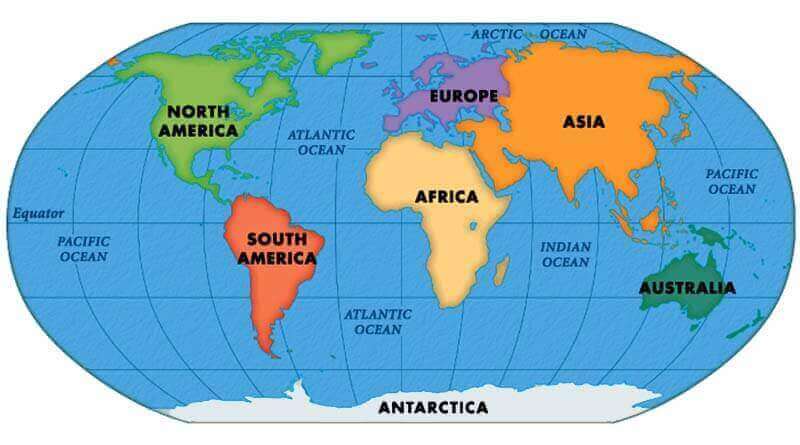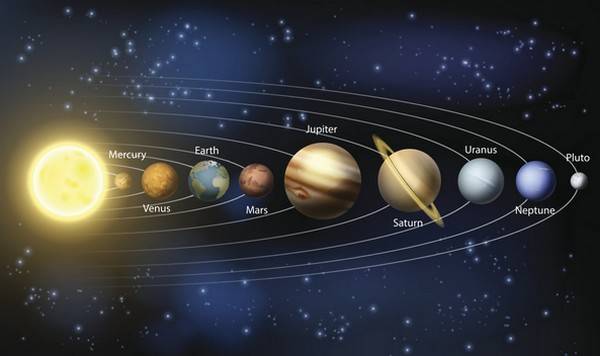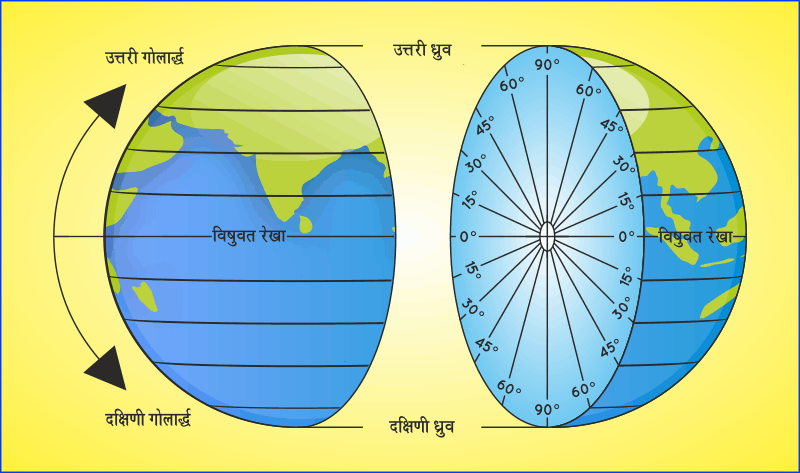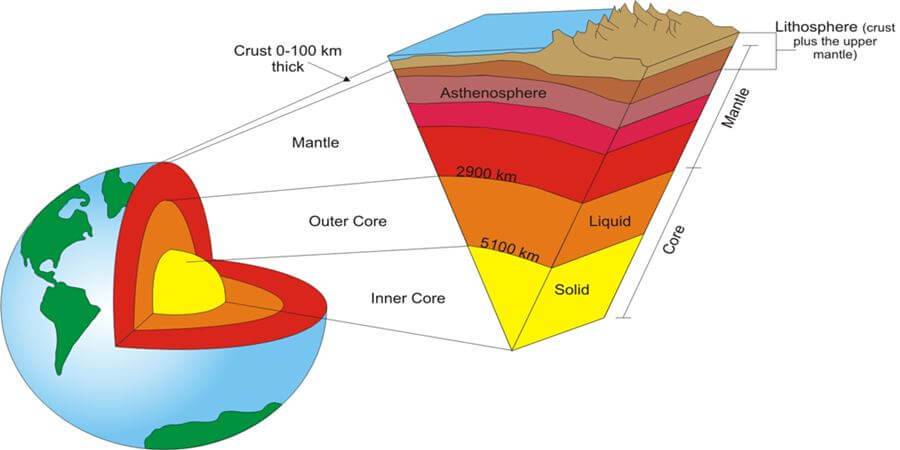Climatology
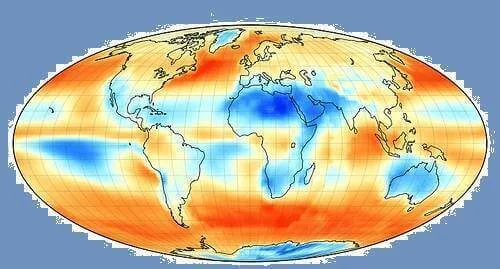
Atmosphere
The Gaseous Cover That Surrounds The Earth, Which Is Sustained Due To The Force Of Attraction Of The Earth, Is Called The Atmosphere. According To Strahler, The Height Of The Atmosphere Ranges From About 16-29 Thousand Km. It Is Estimated That 97% Of The Entire Atmospheric Organization Is Located At An Altitude Of 29 Km. Earth’s Atmosphere Is Made Up Of Various Components Which Include Gaseous Particles, Water Vapor And Dust Particles.
| Different Gases | Volume (In Percentage) |
|---|---|
| Nitrogen | 78.8 |
| Oxygen | 20.24 |
| Argon | 0.93 |
| Carbon Dioxide | 0.036 |
| Neon | 0.018 |
| Helium | 0.0005 |
| Ozone | 0.00006 |
Oxygen Is A Flammable Gas. Nitrogen Dilutes Oxygen And Controls Its Flammability. [At An Altitude Of 120 Km The Amount Of Oxygen Will Be Negligible
Carbon Dioxide Is A Green House Gas. It Is Transparent To Solar Radiation But Acts As Opaque To Earth Radiation. [Carbon Dioxide And Water Vapor Are Found Only Up To A Height Of 92 Km Above The Earth’s Surface.
The Ozone Layer Protects The Earth From Overheating By Absorbing Almost All The Ultraviolet Rays Coming From The Sun. [It Is Found At An Altitude Of 10 To 50 Km Above The Earth’s Surface.
Heavy Gases Such As Carbon Dioxide , Oxygen And Nitrogen Are Found In The Lower Atmosphere [Carbon Dioxide Up To 20 Km And Nitrogen Up To 100 Km] While Lighter Gases Such As Helium, Neon, Krypton And Xenon Are Found In The Atmosphere At Higher Altitudes (Upper Atmosphere). .
Water Vapour
- Acts Like A Blanket For The Earth Which Allows It To Be Neither Too Hot Nor Too Cold. It Absorbs Solar Radiation As Well As Protects The Terrestrial Radiation.
- The Sky Appears Blue In Color Due To The Scattering Of The Rays Coming From The Sun.
- These Solid Particles Are Very Important From The Point Of View Of Climate Because These Solid Particles Act As Hygroscopic Nuclei Around Which Water Droplets Are Formed Due To Condensation.
- Clouds And Various Patterns Of Precipitation And Condensation Come Into Existence Only Because Of These Water Vapor Particles.
Composition Of The Atmosphere
Various Concentrated Layers Of Air Are Found In The Atmosphere. Whose Temperature And Density Differ. The Density Is Highest Near The Earth’s Surface And Decreases With Increasing Altitude. On The Basis Of Vertical Distribution Of Temperature The Atmosphere Can Be Classified Into The Following Parts:
Troposphere
- The Troposphere Is The Lowest And Densest Layer Of The Atmosphere. This Layer Contains About 75% Of The Total Air Mass.
- Its Average Altitude Above Ground Level Is About 14 Km. It Extends Up To A Height Of About 8 Km In The Polar Regions And 18 Km Near The Equator.
- The Thickness Of The Troposphere Is Found To Be Maximum Near The Equator Because The Transfer Of Temperature In These Regions Occurs Due To Convection Wave To Higher Altitudes.
- For These Reasons It Is Also Called The Convectional Layer. Since Dust Particles And Water Vapor Are Found In This Circle, So All The Weather Events Like Fog, Mist, Cloud, Dew, Rain, Hailstorm, Lightning-Thunder, Etc. Take Place In This Circle.
- The Decrease In Temperature With Increase In Altitude Is 1°C At An Altitude Of 165 Meters Or 3.6°F Or 6.5°C/Km At 1000 Feet. Rate Of . This Is Called The Normal Temperature Loss Rate.
- The Pilots Of Jet Aircraft Avoid This Layer Due To The Presence Of Rough Air Packets.
- A Transition Zone Is Found Between The Troposphere And The Stratosphere, Which Is Called The Tropopause.
Stratosphere
- The Stratosphere Extends Above The Troposphere To A Height Of 50 Km.
- In The Lower Part Of This Layer, The Temperature Is Found To Be Constant Up To A Height Of About 20 Km. Thereafter It Gradually Increases To A Height Of 50 Km.
- The Rise In Temperature Is Due To The Presence Of Ozone In This Layer Which Absorbs The Ultraviolet Rays Coming From The Sun.
- The Highest Density Of Ozone Is Found Between 20 And 35 Km. That’s Why It Is Also Called “Ozone Layer”.
- Clouds Are Rarely Found In The Stratosphere And Very Little Dust And Water Vapor Are Found, So It Is Ideal For Jet Planes To Fly.
- The Temperature In The Uppermost Part Of The Stratosphere Is Found To Be 0°C.
- A Transition Zone Is Found Between The Stratosphere And The Mesosphere, Which Is Known As The Stratopuase.
Mesosphere
- The Extension Of The Mesosphere Is Found Up To A Height Of 80 Km Above The Stratosphere. The Temperature In This Layer Decreases With Increase In Altitude And At An Altitude Of 80 Km, The Temperature Is -100°C. It Happens.
- Its Upper Part Is Called The Mesopause .
Thermosphere
The Atmospheric Layer Above The Mesopause Is Called The Thermosphere. The Temperature In This Circle Increases Rapidly With Increasing Altitude. It Is Divided Into Two Parts:
Ionosphere
- Its Topmost Part Is Called The Mesopause.
- The Extent Of The Ionosphere Is Between 80 And 400 Km.
- There Is A Rapid Rise In Temperature In This Layer And The Temperature Reaches 1000 °C In Its Upper Part.
- Radio Waves Are Reflected From This Layer And Come Back To The Earth.
Exosphere
- The Outer Atmospheric Cover After The Ionosphere, Which Is The Upper Atmospheric Part After 400 Km, Is Called The Exosphere.
- This Layer Is Quite Rare And Gradually Mixes Into Space.
- Atoms Of Oxygen, Hydrogen And Helium Are Found In This Layer.
Atmospheric Temperature
- Solar Energy Is The Main Source Of Energy For The Atmosphere.
- Insolation Is The Incident Solar Radiation. It Is Received In The Form Of Short Waves. The Surface Of The Earth Receives 2 Calories Of Energy (2 Cal/Cm/Min) On A Square Cm Of Surface In One Minute. This Is Called The Solar Constant.
- Incident Solar Radiation Is In The Form Of A Beam Of Rays Consisting Of Rays Of Different Wavelengths. The Energy Emanating From The Sun Is In The Form Of Electromagnetic Waves.
- The Long Wavelength Rays That Are Mostly Absorbed In The Atmosphere Are Called Infrared Rays. The Short Wave Rays Are Called Ultraviolet.
Atmospheric Heating And Cooling
- Air, Like Other Substances, Heats Up In Three Ways: Radiation, Conduction And Convection.
- In Radiation, Any Object Or Body Directly Receives Heat Wave And Heats Up. This Is The Only Method In Which Heat Is Transmitted Even In Vacuum. It Is The Most Important Method Of Heat Transfer.
- The Earth Receives Solar Radiation In The Form Of Short Waves And Releases It In The Form Of Long Waves, Which Is Called Terrestrial Radiation.
- Earth’s Atmosphere Is Transparent To Solar Radiation But Acts Almost As Opaque To Terrestrial Radiation. Carbon Dioxide And Water Vapor Are Good Absorbers Of Long Waves.
- The Atmosphere Receives More Heat From Terrestrial Radiation Than From Incident Solar Radiation.
- When The Transfer Of Heat In An Object Is Due To The Movement Of Molecules, It Is Called Conduction. In Convection, Heat Is Transferred Due To The Movement Of Objects From One Place To Another.
Heat Budget
The Balance Between The Amount Of Insolation Received By The Earth And The Terrestrial Radiation Emitted By It Is Called The ‘Heat Budget Of The Earth’.
Pressure Zone And Wind Communication
- Air Has A Weight Of Its Own. Because Of This, The Air Exerts Pressure On The Surface By Its Own Weight. The Weight Exerted By All The Layers Of The Atmosphere Above On The Surface Or On The Sea Level Per Unit Of Area Is Called ‘Air Pressure’. The Atmosphere Exerts An Average Pressure Of About 1 Kg/Sq Cm.
- Air Is Compressed Due To The Effect Of Gravity On The Ocean Floor, So It Is Denser Near The Surface Of The Earth. It Decreases Rapidly With Increasing Altitude. As A Result, Half The Atmospheric Pressure Is Compressed Below 5500 M. 75% Of The Pressure Compresses Below 10,700 M And 90% Below The Tropopause (1600 M).
- Air Pressure Is Measured With An Instrument Called A Barometer, Which Was Developed By Torricelli.
- A More Solid (Concrete) Instrument That Works Without A Meter Long Mercury Tube Is The Aneroid Barometer.
- The Distribution Of Atmospheric Pressure Is Shown With A Map Of Isobars.
Note: .
- Isobar Is A Virtual Line Drawn Through Places Of Equal Atmospheric Pressure Taken At Sea Level.
- The Unit Used By Meteorologists For This Purpose Is Called Millibar.
- The Normal Pressure At Sea Level Is Considered To Be 76 Cm.
- Force On One Centimeter Area By One Millibar 1 Gram
Earth’s Pressure Zone
(A) Equatorial Low Air Pressure
- The Expansion Of This Air Pressure Belt Is In The Form Of A Narrow Band. Here The Rays Of The Sun Fall Vertically. Due To Extreme Temperatures, The Air Expands And Rises When Heated. Soon The Vertical Column Of Clouds Reaches The ‘Tropopause’ And It Rains Heavily.
- Due To The Convergence Of Air In This Belt, The Inter-Tropical Convergence Zone (ITCZ) Is Formed.
- Headley Cell Is Formed In This Compartment.
- This Trade Wind Carries Abundant Moisture. When This Headley Is Mounted With The Help Of Transmission.
- Within The ITCZ, There Is A Calm Atmosphere Due To Low Wind Speed. That Is Why This Belt Is Called Doldrum.
(B) Subtropical High Pressure Belt
- This Belt Is Found Between 30° To 35° North And South Latitudes In Both The Hemispheres. Dry And Warm Air Is Found In This Region. Here The Sky Is Completely Clear And Cloudless.
- Although The Dynamics Behind The Formation Of This Belt Are Very Complex, It Is Generally Formed By The Descent And Subsidence Of Air With The Help Of Hadley Cells.
- When The Convection Of Air Occurs In These Regions, The Air Heats Up And Diverges On The Surface. Anticyclonic Condition Is Found In These Areas. On The Surface It Is The Region Of Deserts Which Is The Most Extensive In Africa And Asia.
(C) Belt Of Subpolar Low Pressure
- The Development Of This Belt Occurs Around 60° And 65° North And South Latitudes.
- The Polar Front Is Formed By The Meeting Of Two Air Masses With Different Temperatures In This Region.
- In The Southern Hemisphere, A Subpolar Cyclonic System Is Formed Around Antarctica In This Belt.
(D) Polar High Pressure Belt
- This Belt Develops Due To Low Temperature.
- Here There Is A Divergence Zone Of Dry And Cold Winds, Due To Which Anticyclonic Condition Is Found Here.
- Here The Wind Direction Is Clockwise In The Northern Hemisphere And Anti-Clockwise In The Southern Hemisphere.
Wind System
- The Horizontal Flow Of Air Is Called Wind. It Appears Due To The Horizontal Difference In Air Pressure. Due To The Horizontal Difference In Air Pressure, Air Flows From High Pressure To Low Pressure. The Vertical Air Circulation Is Called ‘Wind Current’. Wind And Air Current I.E. Horizontal And Vertical Circulation Together, The Whole Atmospheric Circulation
- Let’s Build. Due To The Rotation Of The Earth, The Winds Are Not Able To Intersect The Isobars Directly At Right Angles, But They Deviate Somewhat From Their Main Path. This Deviation Is The Result Of The Earth’s Rotation And Is Called The Coriolis Force.
- Due To The Coriolis Force, The Deviation Of The Wind Direction Is To The Right In The Northern Hemisphere And To The Left In The Southern Hemisphere. It Is Also Called Ferrell’s Law.
Types Of Winds
It Can Be Divided Into Three Parts:
1. Prevailing Wind : Such Winds Usually Blow From One Latitude To Another In The Same Direction Throughout The Year. Chief Among These Are Trade Winds, Westerly Winds And Polar Winds.
2. Seasonal Wind : There Is A Seasonal Change In The Direction Of These Winds. For Example, Monsoon, Terrestrial And Ocean Breeze, Mountain And Valley Breeze Etc.
3. Local Wind : These Winds Blow Locally Over Relatively Small Areas In Different Regions Of The World. They Have Some Characteristics Of Their Own. Their Naming Is Also Related To The Local Languages.
Prevailing Winds ( Planetary Winds ) There Are Two Types Of Prevailing Winds :
1. Trade Winds: The Flow Of This Wind Is Equatorial Low From The Area Of Subtropical High Pressure. Towards The Air Pressure. These Winds Blow Regularly And Continuously Throughout The Year. These Winds Converge Near The Equator In Both The Hemispheres And Their Rise In The Convergence Zone Causes Heavy Rainfall.
2. Westerlies: The Westerly Wind Blows From The Subtropical High Pressure Belt To The Subpolar Low Pressure Belt. Its Direction Is From South-West To North-East In The Northern Hemisphere And From North-East To South-East In The Southern Hemisphere.
Periodic Winds : The Following Winds Come Under This:
Terrestrial And Oceanic Winds : During The Day, The Terrestrial Part Becomes Hotter Than The Water, Due To Which Low Pressure Is Established On The Coastal Part And High Pressure On The Oceanic Part. Due To This Reason, The Winds Start Blowing From The Ocean Towards The Land, Which Is Called Ocean Breeze. After Sunset, The Terrestrial Parts Cool Down Quickly, Causing High Pressure On The Terrestrial Part And Low Pressure On The Oceans. As A Result, Winds Start Blowing From The Land To The Water, Which Are Called Terrestrial Breezes.
Mountain Breeze : During The Day, Due To The High Temperature In The Lower Part Of The Mountain Valleys, The Air Gets Heated Up And Rises Along The Mountain Slopes. They Are Called Ghati Samir. During The Night, There Is More Heat Loss By Radiation On The Mountain Slopes And Upper Parts, Due To Which The Air Becomes Cold. These Cold And Heavy Winds Descend In The Valleys With The Help Of Slopes, Which Are Called Mountain Breezes.
Local Winds Some Of The Local Winds Are As Follows
- Blizzard (Greenland, Canada, Antarctica): These Are Polar Winds Consisting Of Ice Particles.
- Bora (Adriatic Sea): It Is A Dry And Very Cold Wind. Descending From The Southern Slope Of The Alps, These Winds Blow In The South Direction.
- Brick Fielder: This Is The Warm Air That Blows From The Australian Desert. (December To February) Buran (Central Asia And Siberia): It Is A Very Cold Strong Wind Blowing From The North-East Direction. It Brings Down The Temperature To -30°C.
- Chile: It Is A Hot And Dry Wind That Blows From The Sahara Desert Towards The Mediterranean Sea.
- Ghibli: The Dry Wind Blowing From The Sahara Desert Towards The Mediterranean In The Summer In Libya. The Effect Of Ghibli Is Very Strong.
- Habub (Sudan): It Is A Hot Wind That Blows In Summer. Harmattan: The North-East Trade Winds Blowing From The Sahara Desert In West Africa Reach The Guinea Coast As A Dry Wind.
- Karaburan (Tarim Basin – China): It Flows In March And April. This Wind Contributes To The Deposition Of Loess Soil In The Hangho River Valley.
- Khamsin (Egypt): It Is A Hot Wind That Blows During The Summer Season. ‘Loo’ (North-East India): Dusty Warm Wind Blowing In April-June.
- Mistral (Rhne River Valley Of France): This Is A Cold Wind That Blows At 120 Km/H In Winter. Fruit Orchards Are Adversely Affected By This.
- Pampero (Pampas Region Of Argentina): This Cool And Dry Wind Blows In Winter.
- Samoon (Iran And Kurdistan): A Warm Wind That Blows In Summer.
- Simon (Saudi Arabia : This Is A Hot Wind That Blows During The Period From March To July.
- Sirocco (Algeria): It Flows From The Sahara Desert Towards Malta And The Island Of Sicily. It Is Generally Hot And Humid Air.
- Berg (Germany): Descends From The Alps Mountains. It Helps To Melt The Snow In Winter.
- Chinook: It Is A Hot And Dry Wind That Blows From December To March In The States Of Colorado, Montana, North Dakota, Oregon And Wyoming In The United States And Alberta, Manitoba And Mackenzie Region Of Canada, Which Helps To Melt Snow And Ice. It Is Known As ‘Snow Eater’.
- Fawn: Through The Northern Slope Of The Alps, The Upper Rhine River Flows Into The Valley. Levantor: It Is A Slow And Moist Wind Blowing In Southeast Spain, Balearic Islands And Strait Of Gibraltar, Causing Heavy Rainfall In These Areas.
- Leves: Hot And Dry Wind Similar To The Sirocco Wind That Blows Through The Coastal Areas Of Southern Spain.
- Tramontan: It Is A Cold And Dry Wind That Blows In The Western Mediterranean Basin. Gregal: It Flows In The Tyrrhenian Sea And The Coast Of Sicily And The Island Of Malta. This Air Flowing In Winter Is Also Known As Greco.
- Jonda: This Is A Hot, Humid And Painful Wind That Blows In Argentina.
- Southern Buster: A Very Cold And Dry Wind That Blows Over The Argentina-Uruguay Region. This Is The Air Belonging To The Cold Front.
- Phrygem: This Is A Very Cold Strong Wind That Blows In The Compose Region Of Brazil And Eastern Bolivia.
- North Wind: This Is A Cold North Wind That Lowers The Temperature In Texas And The Gulf Coast Of America.
- Papageo: A Cold And Dry Wind That Lowers The Temperature In The Coastal Areas Of Mexico And Brings Clear Weather In Winter.
- Santana: A Hot And Dry Wind That Blows Through The California Valley. It Is The Dusty Air Which Adversely Affects The Orchards.
- Dust Devil: Dusty Wind Blowing Over The Sahara, The Kalahari Desert, Central And Western America, And The Midwest.
- Karaboran: A Strong Dusty North-Easterly Wind Blowing In The Tarim Basin Of Central Asia.
Water Vapor In The Atmosphere
Humidity In The Atmosphere Refers To The Amount Of Water Present In The Atmosphere. Water Present In The Atmosphere Can Exist In All Three States, Namely, Solid (Ice), Liquid (Water) And Gas (Vapor).
Cloud
A Cloud Is A Group Of Water Particles Or Snow Particles That Float In The Atmosphere. The Branch Of Climatology That Studies Clouds Is Called Nephology Or Cloud Physics.
Clouds Are Divided Into The Following Ten Classes By The World Meteorological Organization:
1. Cirrus Clouds : They Are Made Up Of Small Water-Particles At The Highest Altitude, Hence Do Not Rain. Appear Before The Arrival Of Cyclones.
2. Cirro Stratus Clouds: On Their Arrival, Malo Is Formed Around The Sun And The Moon. They Are Usually White In Color And Are Transparent. These Indicate The Arrival Of The Cyclone.
3. Cirro Cumulus Clouds: These White Colored Clouds Are Found In Wavy Form.
4. Alto Stratus Clouds: These Are Thin Sheets Of Brown Or Blue Color That Look Alike. They Make Extensive And Continuous Rainfall.
5. Alto Cumulus Clouds: They Are In The Form Of White Or Gray Wavy Layers. These Are Sometimes Called “Oyster Clouds” Or “Wool Clouds”.
6. Stratus Clouds: These Clouds Are Of Low Altitude And Are Often Mist-Brown In Color.
7. Cumulo-Stratus-Clouds: These Are Brown And White In Colour. They Are Usually Circular And Arranged In A Row. In Winter, They Often Cover The Entire Sky. These Are Generally Associated With Clear And Clear Weather.
8. Cumulus Clouds: Usually They Are In Length, Whose Upper Part Is Domed, But The Base Is Flat. They Are Associated With Clear And Clean Weather.
9. Cumulo-Nimbus-Clouds: These Are Very Broad And Dark Clouds, Whose Expansion Is More In Height. Along With Them There Is A Greater Chance Of Rain, Hail And Thunderstorms.
10. Nimbo-Stratus-Clouds: They Have A Large Vertical Extension. These Are Dark Lower Clouds And Are Near The Surface. These Are Associated With Heavy Rainfall.
Humidity
Humidity Is A Measure Of The Amount Of Water Vapor Present In The Air. The Amount Of Water Vapor In The Air Depends On Evaporation, That Is, Ultimately, On Temperature. If The Temperature Rises, The Air Can Hold More Water Vapor.
The Concentration Of Water Vapor By The Air To Its Full Capacity At A Given Temperature Is Called
There Are Several Ways To Express The Humidity Of The Air:
1. Absolute Humidity: The Actual Amount Of Water Vapor In A Given Volume Of Air At A Specific Temperature Is Called Absolute Humidity.
2. Relative Humidity: The Relative Humidity Is The Ratio Between The Absolute Humidity Of A Given Volume Of Air And The Maximum Amount Of Water Vapor It Can Hold.
3. Specific Humidity: Specific Humidity Is The Weight Of Water Vapor Per Unit Weight Of Air Which Is Expressed As Grams Of Water Vapor/Kg Of Air Water Vapor.
Fog Is A Dense Layer Of Water Droplets On Top Of Smoke Or Dust That Occurs In The Lower Layer Of The Atmosphere. Fog Is A Cloud Located On The Surface Of The Earth.
Forms Of Precipitation
- Water Can Exist In The Atmosphere In The Form Of Three Forms Such As Solid (Year), Liquid (Water) And Gas (Vapor).
- In Climatology, Precipitation Refers To The Product Formed After The Condensation Of Water Vapor Present In The Atmosphere, Which Is Stored On The Surface Of The Earth.
- Rainfall Includes Rain, Snow, Hail, Rain Etc.
Rain
- Rainfall Is A Type Of Precipitation That Comes To The Surface In The Form Of Small Droplets Or Droplets With A Diameter Of More Than 0.5 Mm.
- When Water Droplets Reach The Surface Of Very High Clouds, Some Part Of It Evaporates Only In The Layers Of Dry Air. Sometimes All The Raindrops Evaporate Before They Reach The Surface.
- Conversely, When Precipitation Is Very Active, The Lower Air Becomes Humid And Cloudy, And Then There Is Torrential Rain. In This Rain, The Droplets Are Very Large And In Abundance.
- Based On The Type Of Rainfall, Location And Other Seasonal Characteristics, Rainfall Is Divided Into Three Classes.
1. Convectional Rainfall •
- An Area Of Convective Rainfall Is An Area Of High Temperature And High Humidity. Solar Radiation Is The Main Source For The Generation Of Convection Waves.
- Convective Rain Is Caused By The Formation Of Cumulonimbus Clouds. Lightning, Thunder And Sometimes Snow Fall Are The Characteristics Of This Rain. This Type Of Rainfall Occurs In The Belt Of Doldrums And In The Equatorial Region. Where It Happens Almost Daily In The Afternoon. Such Rainfall Is Not Much Effective For The Crop. Most Of The Water Of This Rain Flows Through The Surface And Gets Into The Sea.
2. Orographical Rainfall
- It Is The Most Widespread Type Of Rainfall. When The Humid Winds Rise Up And Collide With The Mountainous Areas, Then Such Rain Is Called Mountain Rain.
- The Region Where The Winds Hit The Mountain, Receives A Lot Of Rainfall, While The Opposite Slope Is Called “Rain Shadow Region” And These Areas Receive Negligible Amount Of Rainfall. This Is Because The Air In The Opposite Slope Settles Down And Loses Its Moisture.
3. Cyclonic Rainfall
- Cyclonic Rainfall Is Related To The Formation And Development Of Cyclones. This Rain Is Very Beneficial For Agricultural Works.
- In Temperate Regions, Cyclonic Rainfall Occurs In The Form Of Showers Or In The Form Of Light Droplets. It Was Long And Continuous
Shower
- When The Droplets Are Very Small And Uniform In Size And Appear To Be Floating In The Air During Precipitation, It Is Called A Spray.
- The Radius Of Water Droplets In A Spray Is Less Than 500 Μm.
- Such Showers Are Formed Only From A Supersaturated Cloud In Which The Amount Of Water Is Very High. In This, The Relative Humidity Of The Air Between The Cloud Level And The Earth’s Surface Is About 100 Percent, So That These Small Droplets Do Not Vaporize On Their Way.
Snow
- When Snowflakes Come To The Surface During Precipitation, It Is Called Snowfall Or Snowfall. In Other Words, Snow Is The Precipitation Of Solid Form Of Water.
- In The Winter, When The Temperature Drops Below The “Freezing Point”, The Ice Particles Start Coming Directly To The Surface From The ‘Alto-Stratus’ Cloud. These Start Reaching The Surface Without Melting Along The Way.
Sleet
- When Both Water And Snow Particles Reach The Surface In A Mixed Form During Precipitation, It Is Called ‘Snow Rain’.
- Whenever There Is A Strong Wind Current In The Atmosphere In A Vertical Form, Then The Snowfall Takes A Very Terrible Form.
Hail: When Snow Starts Falling In The Form Of Small Grains Whose Diameter Is Between About 5 Mm To 10 Mm, Then It Is Called Hail.
It Typically Receives Snow The Size Of A Pea, But Occasionally Snowfalls The Size Of A Baseball.
It Is The Most Frightening Of All The Precipitation Patterns That Form From The Cumulonimbus Cloud And Reach The Surface With A Fierce Roar.
Dew Dew Is The Moisture Accumulated On The Surface Of The Ground Or Any Substance Located Near It. It Takes Place In A Calm And Clean Environment During The Night. When The Lower Layer Of The Atmosphere Is Cooled Below Dew Point By Ground Radiation, The Water Vapor Condenses Into Droplets. Calm Weather And Clear Sky Are The Best Conditions For Dew To Form.
Cyclone And Anticyclone
The Origin Of Cyclone And Anticyclone Is Due To The Mixing Of Different Types Of Air Masses, Due To The Rapid Rise Of The Air To Take The Form Of A Tornado.
Cyclone
When An Area Of Low Pressure Is Created In The Centre, The Pressure Increases Outwards. In This Condition The Winds Move From Outside To Inside Which Is Called Cyclone. The Wind Direction In A Cyclone Is Anti-Clockwise In The Northern Hemisphere And Anti-Clockwise In The Southern Hemisphere. In A Cyclone, The Air Moves Towards The Center And Cools By Rising Up.
Tropical Cyclones Have A Diameter Of 100-500 Km. They Are Known By Different Names In Different Places.
- Hurricane (USA): It Is A Tropical Cyclone That Develops In The West Indies And The Gulf Of Mexico In The Months Of August-September.
- Typhoon (China): This Is Also A Tropical Cyclone That Develops In The China Sea And Its Adjoining Areas.
- Tornado: Tornado Is The Smallest In Terms Of Size Of Cyclones But Most Destructive And Severe In Terms Of Impact. Tornadoes Occur Mainly In The USA And Secondarily In Australia. Winds In A Tornado Blow At 800 Km Per Hour, Which Is Faster Than Any Type Of Cyclone.
- Willie-Willie: These Are Tropical Storms That Occur In North-West Australia.
- Cyclones: These Are Tropical Low Pressure Storms That Occur Over The Indian Coasts Of The Bay Of Bengal And The Arabian Sea.
Anticyclone
- When The Pressure In The Center Becomes High, The Wind Blows Outwards. This Is Called Anticyclone And It Lacks Front. The Wind Direction Is Clockwise In The Northern Hemisphere And Anti-Clockwise In The Southern Hemisphere.
- Anticyclone Does Not Move In Any Fixed Direction. The Weather Associated With It Is Mainly Nice And Dry.

